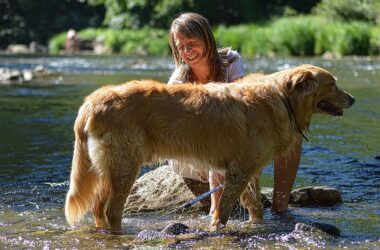In the heartwarming world of pet ownership, there’s a special art that goes beyond the ordinary routine of feeding, walking, and cuddling. It’s the art of pet grooming, a delightful practice that transforms our beloved fur babies into fresh and fabulous companions. “The Art of Pet Grooming: Keeping Your Fur Baby Fresh and Fabulous” is an exploration of this essential yet often underestimated aspect of pet care—a journey that unveils the secrets to maintaining not only your pet’s physical well-being but also their confidence, comfort, and undeniable charm.
Grooming isn’t just about aesthetics; it’s a manifestation of love and dedication to our animal companions. It’s a gentle touch, a soothing brush, and a caring gesture that fosters a deeper connection between us and our pets.So, join us in this exploration of love, care, and the timeless art of pet grooming, where every brushstroke and bath is a testament to the bond we share with our loyal and beloved companions.

Understanding your pet’s coat type
Understanding your pet’s coat type is a fundamental step in the art of pet grooming, as it lays the foundation for the grooming routine that best suits their specific needs. Just as humans have different hair types, our pets come with a wide variety of fur textures, lengths, and thicknesses, and each requires a tailored approach to maintain their health and appearance.
Short Coats: Pets with short coats, like the Dachshund or Beagle, often have fur that lies close to the body. While these coats are relatively low-maintenance in terms of brushing, they do benefit from regular grooming to remove loose hair and promote a healthy, shiny appearance. A soft-bristle brush or grooming mitt is typically sufficient for short-coated breeds.
Long Coats: Breeds like the Afghan Hound or Maltese boast long, flowing fur that adds elegance to their appearance. Regularity is key, as skipping brushing sessions can result in painful mats that need to be cut out. Pin brushes, slicker brushes, and combing are often necessary to keep long coats in top condition.
Double Coats: Many breeds, including the German Shepherd and Siberian Husky, possess a double coat consisting of a soft, insulating undercoat and a coarser topcoat. Grooming these coats involves removing loose undercoat hair to prevent shedding and matting while preserving the integrity of the topcoat. Tools like undercoat rakes and deshedding brushes are invaluable for managing double coats.
Curly or Wavy Coats: Breeds like the Poodle or Bichon Frise have curly or wavy fur that can become easily tangled. Regular brushing and occasional professional grooming are essential to maintain these coats. The texture of their fur often requires specialized grooming tools and techniques, such as clipping or hand-stripping, depending on the breed.
Hairless or Minimal Coat: Some breeds, like the Sphynx cat or Chinese Crested dog, have minimal or no fur. While these pets don’t require traditional brushing, they have unique grooming needs, including skincare to prevent sunburn or dryness. Maintaining a clean, healthy skin surface is vital for these breeds.

Thick and Dense Coats: Breeds like the Samoyed or Chow Chow boast thick, dense fur that can be prone to matting. These coats require regular brushing and detangling to prevent mats and maintain the fur’s insulation properties. A combination of slicker brushes, undercoat rakes, and dematting tools may be needed.
In conclusion, understanding your pet’s coat type is the first step in tailoring a grooming routine that keeps them looking and feeling their best. Beyond aesthetics, regular grooming contributes to their overall health and comfort. By selecting the appropriate grooming tools and techniques for your pet’s coat, you not only enhance their appearance but also strengthen the bond you share through the care and attention you provide.
Brushing and combing: The foundation of good Pet grooming
Brushing and combing form the cornerstone of good pet grooming practices for your beloved pet, regardless of their coat type. These essential grooming routines go beyond enhancing your pet’s appearance; they are vital for their overall health and well-being.
Regular brushing and combing serve several crucial purposes:
1. Removing Loose Fur: One of the primary benefits of brushing is the removal of loose hair and debris from your pet’s coat. This not only reduces shedding around your home but also prevents mats and tangles, which can be painful and uncomfortable for your furry friend.
2. Distributing Natural Oils: Brushing helps distribute the natural oils produced by your pet’s skin throughout their coat. These oils provide essential moisture and contribute to a shiny and healthy appearance. For long-haired breeds, this oil distribution can be especially important.
3. Promoting Blood Circulation: The act of brushing stimulates blood circulation in your pet’s skin, promoting overall skin health and comfort. It can also help identify any irregularities or skin issues, such as lumps or irritations, which can be addressed promptly.
4. Bonding and Comfort: Regular grooming sessions are an opportunity for bonding and trust-building between you and your pet. Many animals find the act of being brushed or combed soothing and enjoyable, strengthening the emotional connection you share.
The choice of grooming tools depends on your pet’s coat type. Slicker brushes, which have fine, wire bristles, are effective for removing loose hair and preventing mats in long-haired breeds. For double-coated breeds, an undercoat rake can help remove the dense undercoat without damaging the topcoat. Bristle brushes are suitable for short-haired breeds, while pin brushes work well for long or curly coats. Additionally, combs with wide and narrow teeth are essential for detangling and removing debris.
When brushing or combing your pet, be gentle and patient, especially if they are not accustomed to the grooming process. Start with short sessions and gradually increase the duration as your pet becomes more comfortable. Always use grooming tools appropriate for your pet’s coat type, and never pull or tug at mats or tangles, as this can be painful. For stubborn mats, consider using a mat splitter or detangler spray to make the process easier on your pet.
In conclusion, brushing and combing are foundational aspects of pet grooming that contribute significantly to your pet’s well-being. Beyond the cosmetic benefits, these routines promote a healthy coat, skin, and circulation, while also nurturing the bond you share with your furry companion. By making grooming a regular and positive experience, you not only keep your pet looking fabulous but also ensure they feel their absolute best.
Bathing and nail trimming
Bathing and nail trimming are two essential components of a comprehensive pet grooming routine that contribute to your furry friend’s hygiene, comfort, and overall well-being.
Bathing: The frequency of baths largely depends on your pet’s breed, lifestyle, and individual needs. While some dogs and cats may need regular baths, others may require them less frequently. Bathing serves several vital purposes, including the removal of dirt, debris, and odors from your pet’s coat, which can help prevent skin irritations and matting. It’s also an opportunity to inspect your pet’s skin for any irregularities, such as rashes or hot spots, and address them promptly. When bathing your pet, use a gentle, pet-specific shampoo to avoid stripping their skin of natural oils. Ensure that the water temperature is comfortable, and be patient and calm throughout the process, as some pets may find baths stressful.

Nail Trimming: Regular nail trimming is essential for your pet’s comfort and mobility. The frequency of nail trimming varies depending on your pet’s activity level and whether they naturally wear down their nails. You can trim your pet’s nails at home using pet-specific nail clippers, or you can opt for professional grooming services. If you’re not experienced with nail trimming, it’s advisable to seek guidance from a veterinarian or professional groomer to avoid cutting the quick, which can be painful and cause bleeding. Regular nail maintenance not only ensures your pet’s comfort but also prevents potential joint and posture issues that can arise from long nails.
Both bathing and nail trimming are essential aspects of pet care that, when done correctly and regularly, contribute to your pet’s physical comfort and hygiene. Moreover, these grooming routines provide opportunities to strengthen the bond between you and your furry companion, as they learn to trust and cooperate during these necessary grooming sessions.
Other pet grooming tasks, such as ear cleaning and teeth brushing
the basics of brushing, bathing, and nail trimming, there are other important pet grooming tasks that play a crucial role in maintaining your pet’s overall health and hygiene: ear cleaning and teeth brushing.
Exotic Pets: A Look into Unique and Unusual Animal Companions
Ear Cleaning: Cleaning your pet’s ears is a vital yet often overlooked aspect of grooming. Ear infections and issues can be common, especially in breeds with floppy or hairy ears. Regular ear cleaning helps prevent the buildup of dirt, wax, and moisture, which can create a breeding ground for bacteria and lead to infections. When cleaning your pet’s ears, use a gentle, pet-specific ear cleaner and a soft, lint-free cloth or cotton ball.Gently wipe the visible parts of the ear and clean any folds or crevices. If you notice signs of infection, such as redness, swelling, discharge, or a foul odor, consult your veterinarian for guidance.
Dental issues, such as gum disease and tooth decay, can lead to pain, discomfort, and even systemic health problems if left untreated. Regular teeth brushing helps prevent these issues by removing plaque and tartar buildup. Use a pet-specific toothbrush and toothpaste, as human products can be harmful to pets if swallowed. Start slowly and introduce toothbrushing gradually, making it a positive and rewarding experience. Brushing your pet’s teeth several times a week is ideal, but even once a week can significantly improve their oral health. Dental chews and toys designed to promote dental health can also complement your pet’s oral care routine.

Both ear cleaning and teeth brushing are vital for your pet’s comfort and overall well-being. Incorporating these grooming tasks into your pet’s routine not only maintains their physical health but also contributes to their overall quality of life. Additionally, regular grooming provides opportunities for you to bond with your pet and show them love and care in a meaningful way.
Tips for making pet grooming a positive experience for your pet
Making pet grooming a positive experience for your pet is not only essential for their well-being but also for fostering a strong bond between you and your furry companion. Here are some valuable tips to ensure that grooming sessions are enjoyable and stress-free for both you and your pet:
Start Early and Gradually: Introduce grooming to your pet at a young age, if possible. Puppies and kittens are generally more adaptable and receptive to new experiences. Begin with short, gentle grooming sessions and gradually extend the duration as your pet becomes more comfortable. For older pets who are new to grooming, approach the process with patience and understanding.
Positive Reinforcement: Use positive reinforcement techniques to reward your pet during and after grooming. Offer treats, praise, and affection as rewards for calm and cooperative behavior. Associating grooming with positive experiences can help your pet view it as a pleasant activity.
Desensitization: Help your pet become accustomed to the grooming tools and the grooming process itself. Start by allowing them to investigate and become familiar with the tools without using them. Touch and handle your pet’s paws, ears, and other grooming-sensitive areas gently and positively. Gradually introduce the tools, like brushes or nail clippers, during short and non-threatening sessions.
Take Breaks: Be mindful of your pet’s tolerance level. If they become stressed or agitated during grooming, take breaks as needed. Give them a chance to relax and return to the grooming session later. It’s essential to maintain a calm and patient demeanor throughout to avoid escalating your pet’s anxiety.
Consistency: Establish a regular grooming routine. Consistency helps your pet know what to expect and can make them more comfortable with the process over time. Set a schedule for brushing, bathing, nail trimming, and other grooming tasks and stick to it as closely as possible.
Professional pet Grooming: Consider seeking professional pet grooming services, especially if your pet has a particularly challenging coat or if they become extremely anxious during grooming. Professional groomers have the expertise and experience to handle grooming efficiently and with minimal stress to your pet.
Stay Calm and Gentle: Your attitude and demeanor during pet grooming sessions greatly influence your pet’s experience. Stay calm, patient, and gentle. Speak to your pet in soothing tones and offer reassurance throughout the process. If you are anxious or frustrated, your pet may pick up on these emotions, making grooming more stressful for them.
Know Your Pet’s Limits: Pay attention to your pet’s signals and body language. If they show signs of distress, such as growling, hissing, or trying to escape, respect their boundaries and take a step back. Some pets may have specific sensitivities or fears that require extra care and patience.
In conclusion, making pet grooming a positive experience for your pet is an ongoing process that involves patience, understanding, and positive reinforcement. By taking a gradual and gentle approach, you can help your pet view grooming as a comfortable and even enjoyable activity, strengthening your bond and ensuring their overall well-being.
Conclusion
In the world of pet ownership, “The Art of Pet Grooming: Keeping Your Fur Baby Fresh and Fabulous” has unveiled the secrets to not just grooming but to nurturing a deeper connection with our beloved animal companions. Grooming is not merely a cosmetic endeavor; it is an act of love, care, and dedication that enhances our pets’ physical comfort, emotional well-being, and overall quality of life.
Throughout this journey, we have explored the significance of understanding your pet’s coat type, the fundamentals of brushing and combing, the importance of bathing, nail trimming, ear cleaning, and teeth brushing, and the tips and techniques for making grooming a positive experience. We have discovered that grooming transcends aesthetics; it is an opportunity for bonding, trust-building, and communication between you and your pet.
As we conclude this exploration of the art of pet grooming, we are reminded that grooming is not a one-size-fits-all endeavor. Each pet is unique, with specific needs and sensitivities. By tailoring your grooming routine to your pet’s individual requirements and preferences, you not only ensure their physical well-being but also deepen the bond you share. Grooming becomes an expression of love, care, and devotion—a way to reciprocate the unconditional love and joy your furry companion brings into your life.
In the art of pet grooming, we celebrate the beauty of this timeless connection, where every brushstroke, bath, and gentle touch is a testament to the profound bond between humans and their fur babies. It’s a journey where both you and your pet emerge not only fresh and fabulous but also closer, happier, and more connected than ever before.





